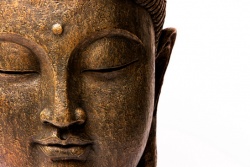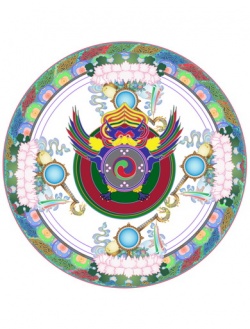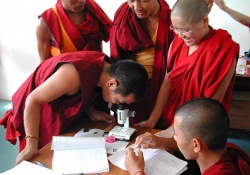The Good Medicine for All Ills
HAVE received the two baskets of leached persimmons1 and the basket of eggplants you sent. Concerning the matter of [your husband] the lay priest’s illness, there were physicians in China named Huang Ti and Pien Ch’üeh, 2 and there were physicians in India named Water Holder3 and Jivaka. They were the treasures of their age and teachers to the physicians of later times. But the man called the Buddha was a superb physician who far surpassed them. This Buddha expounded the medicine of immortality. This is the five characters of Myoho-renge-kyo we have today. Moreover, he specifically taught that these five characters are “good medicine for the ills of the people of Jambudvipa.”
The lay priest is a man of Japan, which lies within Jambudvipa, and furthermore he suffers from bodily illness. The sutra passage about good medicine for illness is clear. In addition, this Sutra of the Lotus is the greatest medicine. When a wicked ruler named King Virudhaka killed more than five hundred women of the Buddha’s clan, the Buddha sent Ananda to Eagle Peak for blue lotus flowers that he then touched to the bodies of the women, who were restored to life and after seven days were reborn in the heaven of the thirty-three gods.
Because the flower known as the lotus is a flower possessing such excellent virtue, the Buddha likened it to the Mystic Law. Also, a person’s death is not determined by illness. In our own time, the people of Iki and Tsushima, though not suffering from illness, were slaughtered in an instant by the Mongols.
It is not certain that, because one is ill, one will die. And could not this illness of your husband’s be the Buddha’s design, because the Vimalakirti and Nirvana sutras both teach that sick people will surely attain Buddhahood? Illness gives rise to the resolve to attain the way. Among all the diseases, the Buddha worried that the five cardinal sins, incorrigible disbelief, and slander of the Law were especially grave ones.
Without a single exception, the people of Japan today are afflicted with the most serious of all illnesses, the grave illness of major slander. I refer to the followers of the Zen, Nembutsu, and Precepts schools, and to the True Word teachers. Because their illness is so serious, neither do they recognize it in themselves, nor are others aware of it. And because this illness worsens, warriors from throughout the four seas will attack at any moment, and the ruler, his ministers, and the common people will all sink into the sea. To see this before one’s very eyes is indeed a painful thing.
In his present life, the lay priest does not appear to have had particularly strong faith in the Lotus Sutra. But due to the workings of his karma from the past, he has sunk into this long illness and now seeks the way day and night without cease. Any minor offenses he committed in this lifetime have probably already been eradicated, and the great evil of slander will also be extinguished because he has taken faith in the Lotus Sutra.
If he were to go right now to Eagle Peak, he would be as delighted as if the sun had come out and he were able to see in all ten directions. He would rejoice, wondering how an early death could be so happy a thing. No matter what may happen on the road between this life and the next, he should declare himself to be a disciple of Nichiren. Although Japan is a tiny country, if one but announces that one is a vassal of the lord of Sagami, people will unaccountably fear one.
I am the most unreasonable priest in Japan, but with regard to believing in the Lotus Sutra, I am the foremost sage in Jambudvipa. My name resounds throughout the pure lands of the ten directions, and heaven and earth no doubt know it. If your husband declares that he is Nichiren’s disciple, I do not think that evil demons of any kind can claim ignorance of my name. I have no words to express my thanks for your frequent sincere offerings. With my deep respect.
Monkeys rely on trees, fish rely on water, and women rely on men. Being loath to part from your husband, you shaved off your hair and dyed your sleeves black.5 Thinking, “How could the Buddhas of the ten directions possibly not feel compassion for me?” and “How could the Lotus Sutra ever abandon me?” rely on them, rely on them! Nichiren
The sixteenth day of the eighth month
Reply to the lay nun Myoshin
Background This letter was written at Minobu to the lay nun Myoshin. The most widely accepted view suggests that it was written in the first year of Koan (); another view is that it was written in the first year of Kenji (). Few details about Myoshin are known. One explanation identifies her as the wife of the lay priest Takahashi Rokuro Hyoe, and if this is correct, she would have been an aunt of Nikko Shonin. In any event, she lived in Fuji District of Suruga Province and was a follower of Nichiren Daishonin. This letter was a reply to a report from Myoshin about her husband’s illness.
The Daishonin encourages her to view his illness as a manifestation of the Buddha’s compassion, since it has enabled him to arouse a determination to seek enlightenment—a determination that he previously lacked. He explains that, because of the sincerity of her husband’s recently awakened faith, he will certainly be able to eradicate the bad karma of his misdeeds; and even if he were to die now, he would experience the boundless joy of the Law that transcends both life and death. When her husband eventually died of his illness, Myoshin was left with a young child. She maintained her faith after her husband’s death and visited the Daishonin often at Minobu to bring him offerings.
Notes
1. Persimmons from which the astringency has been removed by soaking them in a solution of lime or buckwheat chaff.
2. Huang Ti, or the Yellow Emperor, was one of the legendary Three Sovereigns of ancient China. According to Records of the Historian, among other major contributions to civilization, he initiated the art of medicine. Pien Ch’üeh was a physician of China’s Spring and Autumn period (– B.C.E.). He learned the medical arts in boyhood and is said to have been skilled in treating virtually all forms of disease.
3. According to the Golden Light Sutra, a skilled physician who lived countless kalpas ago in the Middle Day of the Law of Treasure Excellence Buddha. When an epidemic broke out, Water Holder, then a very old man, taught the medical arts to his son, Water Carrier, enabling him to save the people.
4. Lotus Sutra, chap. . 5. The Daishonin is referring here to Myoshin’s having become a lay nun. 939


